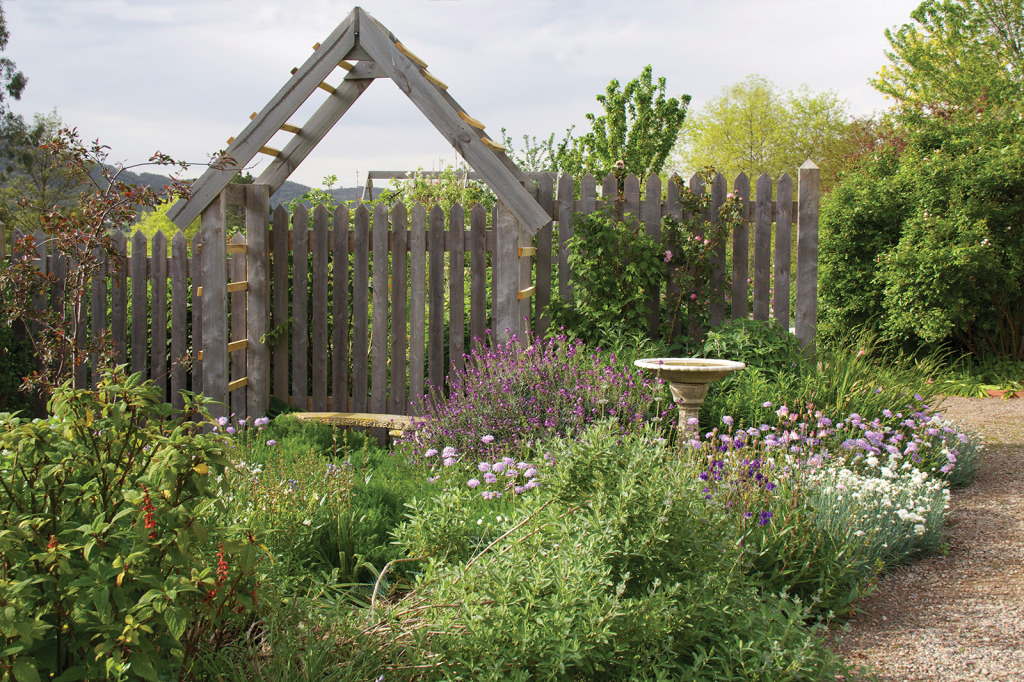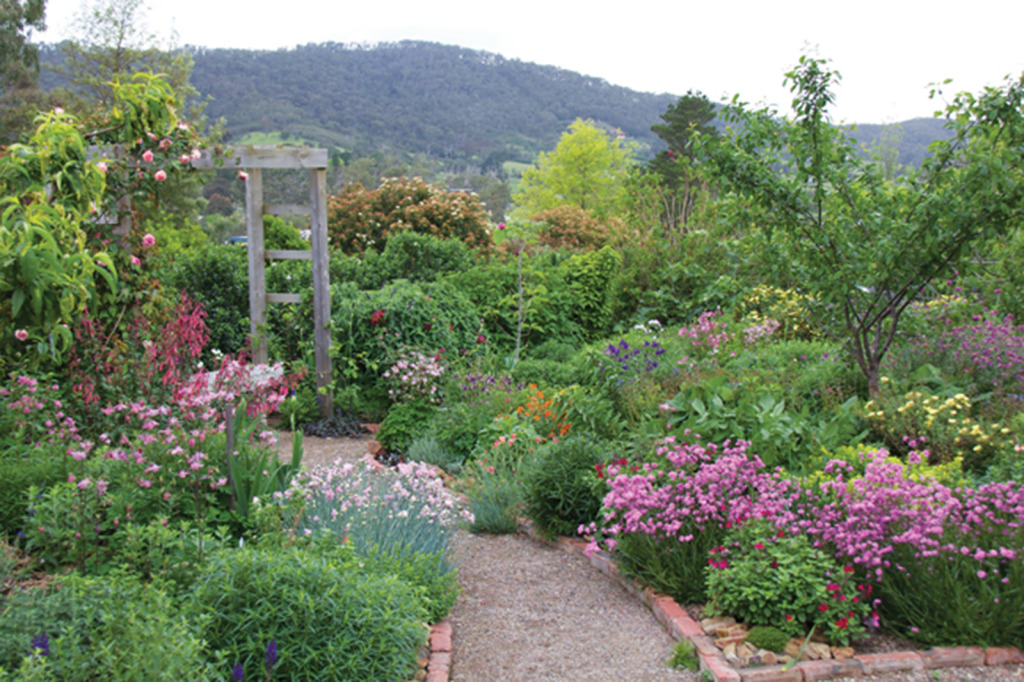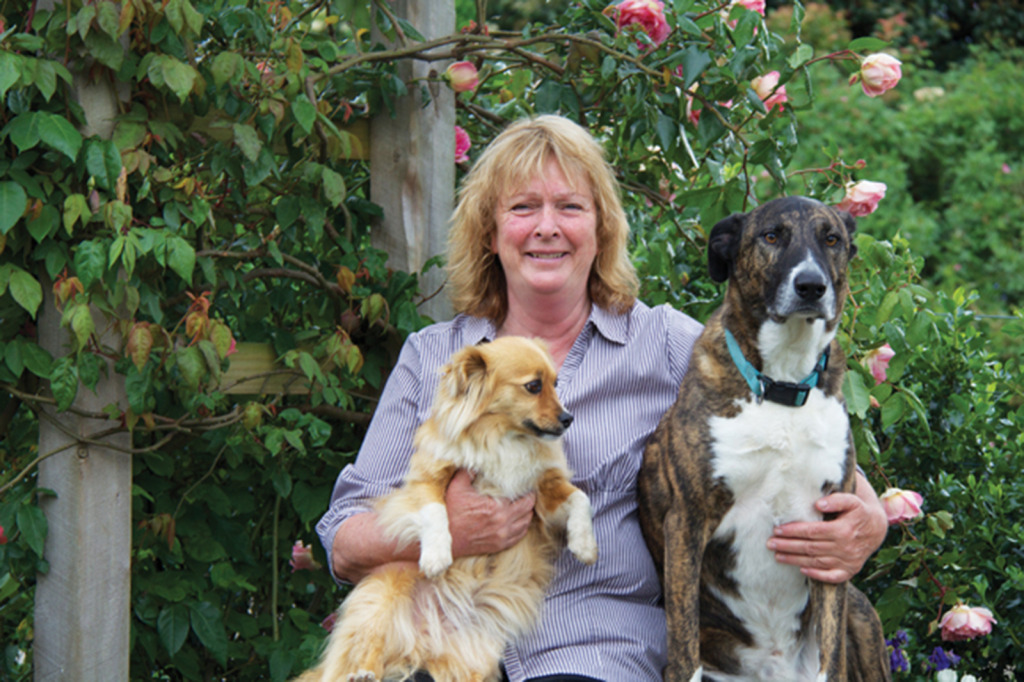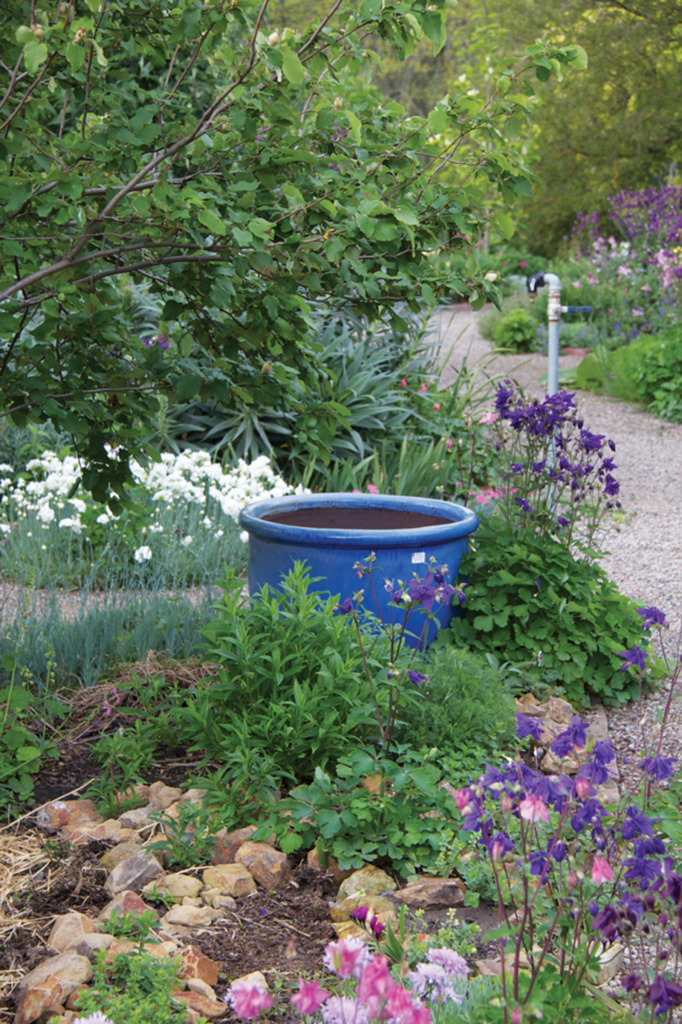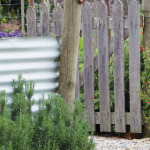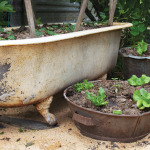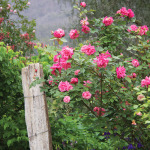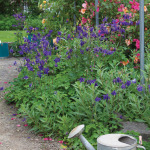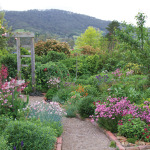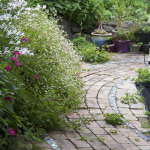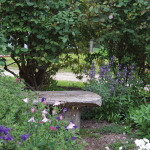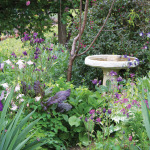Annette Conrad is an adventurous gardener. For one who cares deeply about garden pictures and vistas, who plans the garden and refines it constantly, she can toss together gold iris and blue columbines with burnt-orange winter wallflowers and lemon African daisy and it all looks exuberant with masses of bluebells in the warm spring sunshine. But of course it’s not that simple.
Annette and Gary live in a peaceful horse and cow-filled valley between Healesville and Dixon’s Creek in the Yarra Valley. Eucalypts top the hills and the garden looks out to wonderful views. On a 50-acre (20 ha) property they have formed a one third hectare (almost one acre) garden tended by Annette with lawns mown by Gary around their home of many years. The garden boasts two ancient apple trees but much else was lost on Black Saturday; despite this they consider themselves very fortunate: “Our home and all our animals were saved,” they said.
Today their garden, ‘Wallingford’, bears no outward signs of the bushfire. The close family has built several wooden arbours, some with seats. The leylandii hedge has been replaced with white-flowering Escallonia iveyi to reduce dust, and for privacy. Hundreds of lost roses have given way to perennials – but this may be far more due to Annette’s changed interest. She explained that when the children grew up and she had more time, she also saw her garden afresh after visiting the gardens at Lambley Nursery and Heronswood (home of Digger’s Seeds). She realised that you could rearrange plants to make artistic garden pictures. Annette’s use of colour has been influenced too, by Monty Don and images of Monet’s garden at Giverny.
At first glance this is a country-style garden with a cottage garden in the sunny area between house and road, with roses and lawn to the side, and a little shade at the rear with a vegetable garden near a chicken run and orchard. But, it’s more than this with planned vistas, colours, textures and collections of favourite plant genera such as Salvia, Dianthus and cranesbills (true Geranium). Like the original cottage gardens, Annette has placed fruit trees in the garden with herbs and flowers interspersed but with a colour sensibility, unusual perennials and meandering paths to boot. It’s possible to step into a bed, pick a peach, brush a fragrant herb, and step back to sit under a rose-bedecked arbour to munch it, and that doesn’t happen without good planning. Other fruit trees here include apples, blossom-covered quinces and crabapples.
“Annette pores over her garden plans,” said Gary who enjoys looking at the garden from the mower and deciding which part is his favourite that week.
Curving gravel paths (widened since the bushfire) are softened by charming self-sown seedlings and thyme, while one arbour has a chamomile path to it, adorned with a seat where Annette and Gary love to sit and enjoy the view, enhanced with the scent of the herbs. Nearby is a birdbath too, and blue pots, a recurring motif, harmonized with Scabiosa, bluebells both blue and dusky pink, and rich purple winter wallflower. Large clumps of cut-leaf silver leaves of globe artichoke stand out as do the swathes of bright azure bluebells, chartreuse euphorbias and silvery leaves of peony poppies. Interesting bulbs include pineapple lily (Eucomis) and foxtail lilies (Eremuris).
Some plant combinations that are particularly pleasing the day I visit include lemon marguerite daisies, sky-blue borage and bluebells foiled by golden oregano. Elsewhere we see purple Erysimum, white campion (Silene), violet cranesbill (Geranium) and white Dianthus which jostle beneath a deep pink cherry tree. Deep red velvety wallflower is complemented exquisitely by silvery Teucrium.
As we pass a deep crimson rose near a burgundy Salvia Annette reflects that these are too similar in colour with no contrasting or lightly complementary plants, and thinks about how to improve this garden picture; pale pink columbines (Aquilegia) are coming up nearby, she said. It’s this constant quest for beautiful vistas, rather than positioning plants only where the plant will perform well, that informs this style; as well as a desire to have mixed plantings of shrubs, perennials and bulbs in varying heights so that deep borders can be looked into with an unexpected tableaux of plants – often with colours matched as if by a master seamstress.
And a master seamstress she is, although Annette prefers to call her creative sewing and quilt-making `the gentle arts’. Inside their farmhouse I am shown a superb memory quilt (overseen and partly made by Annette) honouring their daughter, Gillian, a well-loved vet nurse, and they tell me of Gillian’s Rainbow Bridge, a charity to assist and bring together disadvantaged children and rescued animals so that both can heal.
Annette works with her site, using appropriate plants for the hot north winds and the cold winter frosts in this valley. Most salvias grow well here and have led to an interesting collection including rare burnt orange Salvia africana-lutea and Annette’s favourite, deep blue Salvia semiatrata with its dark blotch on each flower. Drought-tolerant Salvias are a good choice, too, because Annette and Gary are reliant upon rainwater tanks and dam water. Where a tall Pride of Madeira (Echium) has woody petticoats she has planted dwarf salvia along with penstemon and dwarf bearded iris to completely hide the ugly base – not an easy task. If plants don’t please or work, they may be removed.
An unusual feature in this garden is that around many plants is a circle of little rocks; this has become an essential armoury in the battle against rabbits, stopping them digging up newly planted plants. It also works as a mulch and keeps soil cool which is useful for species such as Geranium. Welcome visitors, however, are numerous birds such as finches, superb blue wrens, silver thrushes and even a wedge-tail eagle.
A different mood is at play at the side of the house. Here there are generous lawns, a dam, some trees, and several lovely old roses including Rosa mutabilis with its single flowers of honey-yellow, orange and pinkish-red. It’s satisfying to see large old-fashioned roses allowed to swoop out to their natural limits in a country garden with space enough, generously given, to allow these beauties free rein. Some old favourites are here: double soft pink, fragrant ‘Duchesse de Brabant’; sweetly scented double creamy-white climbing ‘Sombreuil’; velvety pink-violet, perfumed, ‘Reine des Violettes’; and delicate pink, strongly perfumed Centifolia ‘Fantin Latour’. Annette’s favourite is ‘Agathe Incarnata’, a Gallica rose bred in 1800 which she says is highly scented with soft pink flowers that are tightly quartered and the petals, when open, are reminiscent of crumpled and torn crepe paper or silk- very beautiful.
Rose lovers will enjoy this garden. Narrower paths leading to seats give an intimate atmosphere at the other side and rear of the house, where there is a double hedge and shade for the hottest days. One in particular is a little path – made by Annette – of blue tiles and red bricks which curves enticingly towards a secluded, pretty café table and chairs which are, partially, that very Australian colour, rust; matched by nearby bronze fennel, russet tips of roses, and a tall salvia with brick-red flowers and bronze calyces. It’s subtle colouring, but masterly.
Lastly we visit the organic vegetable garden and polyhouse and I say hello to the chickens, brown, black and white, with a handsome rooster, in the orchard. Vegetables growing include rainbow chard, red kale and mustard and I spy rhubarb also. Summer vegetables are planted in November after the danger of frost is over in this cool valley. This year, of the many interesting vegetables Annette grows, black cherry tomatoes are being grown from seed and are planted by the cycles of the moon.
Violets flower at Wallingford in winter, so Annette can usually find many flowers in her garden for a lovely posy for friends at any time of the year. She loves to share her garden with others which shows a generous spirit. Her rose garden is generous too but it’s her large sunny cottage garden full of uncommon perennials and combinations that is particularly interesting. This is not just a garden that has recovered from bushfire but blossomed since into something finer. It is full of colour, fragrance and sensuous herbs placed with a sure instinct. Add those magnificent views and you have a special place indeed.
Words by Jill Weatherhead Photographs by Rebecca Faltyn



